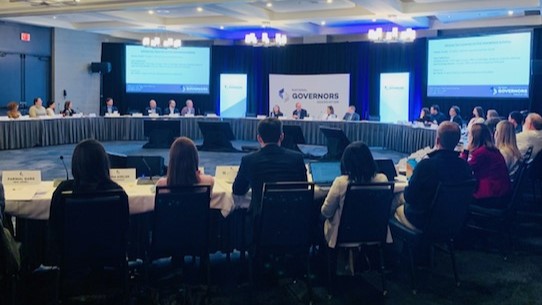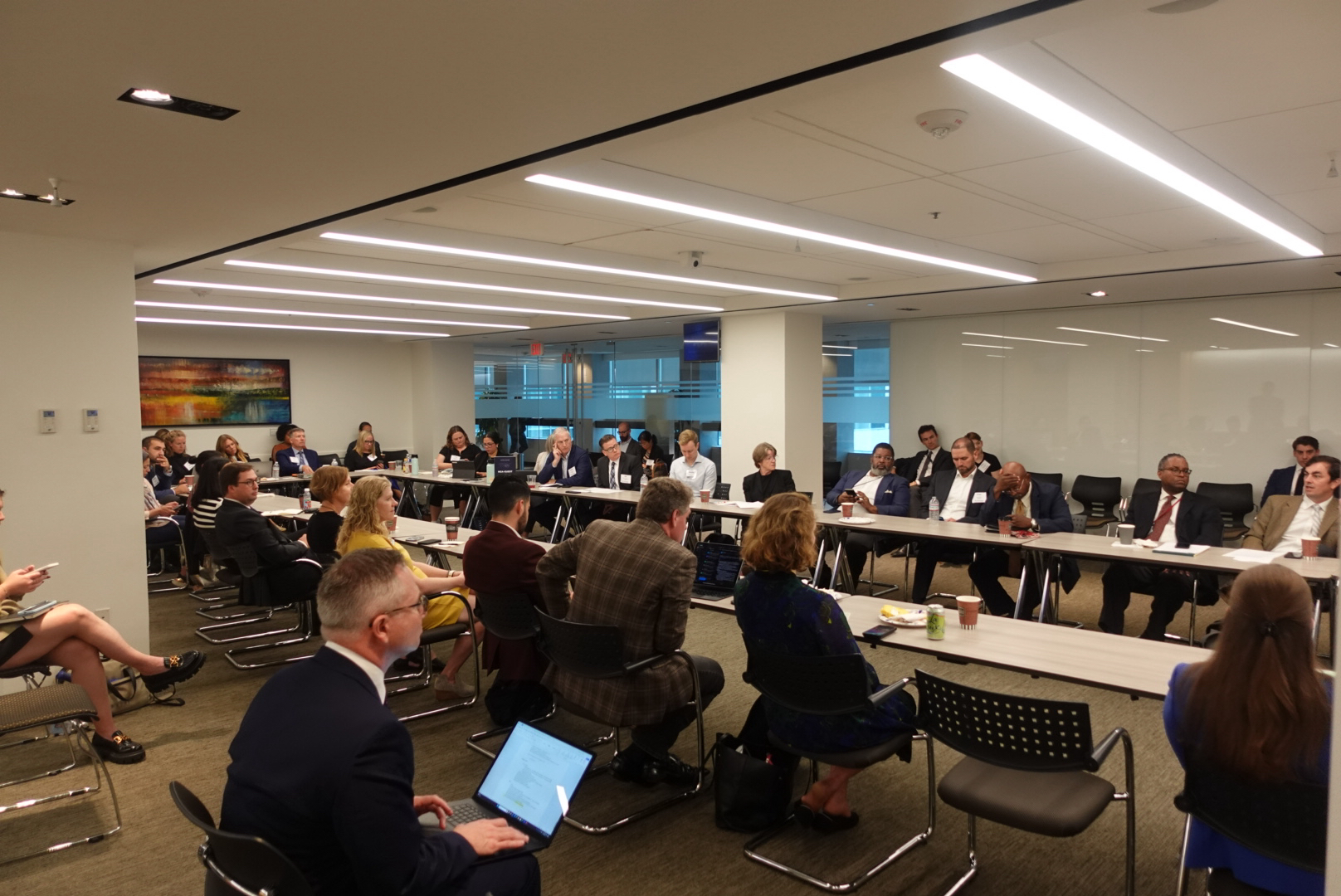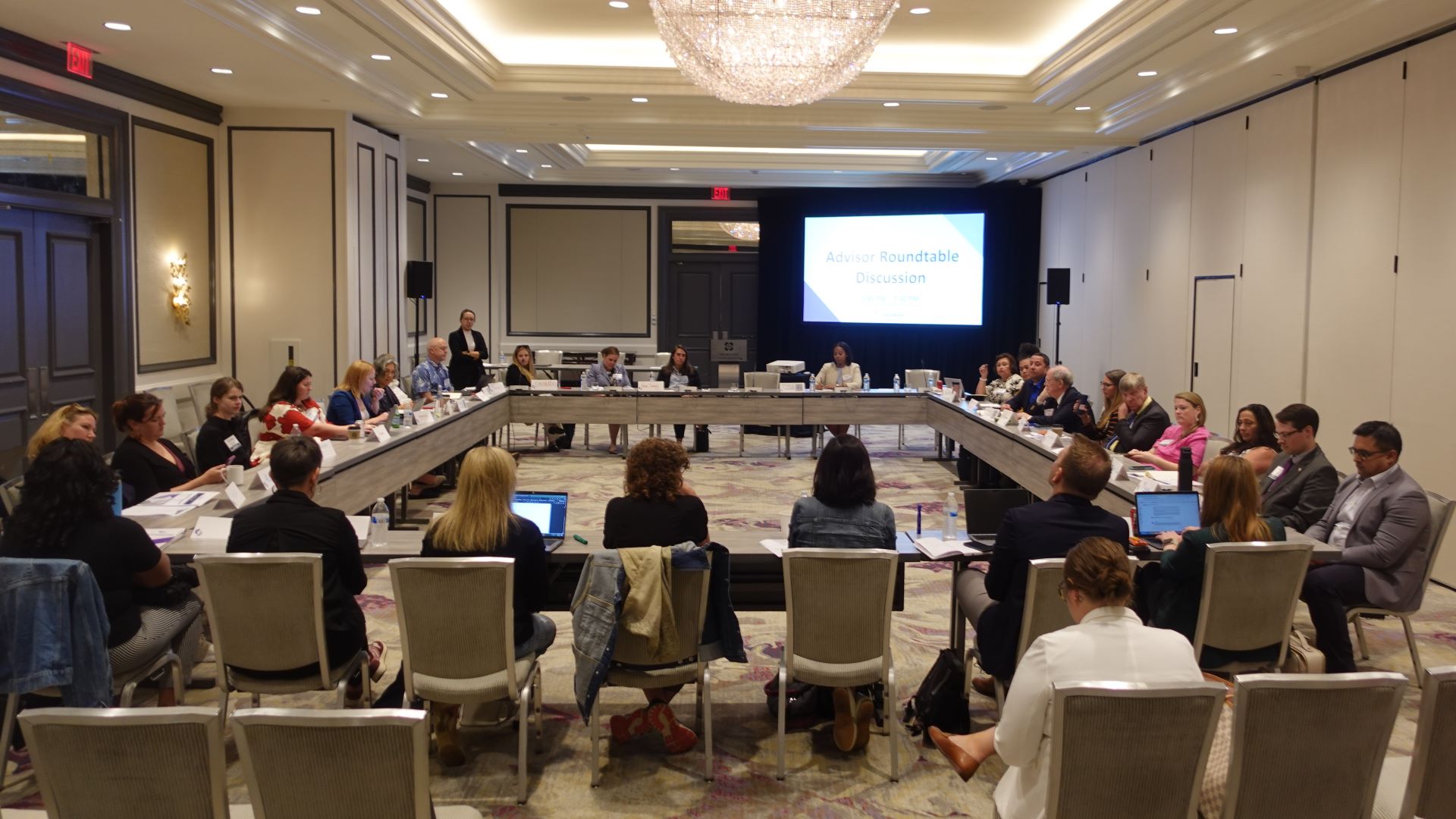This publication highlights key themes from the Policy Academy, recounts Governor-led policy change on youth apprenticeship, and covers what the future of youth apprenticeship policy may hold at the state and federal level.
(Download)
The National Governors Association Center for Best Practices (NGA Center), in partnership with New America, launched the Policy Academy to Advance Youth Apprenticeship in August 2023. Teams from Alabama, Colorado, Indiana, Kansas, North Carolina and Utah were competitively selected to participate in the yearlong Policy Academy to develop and implement their Governor’s youth apprenticeship policy agenda. Each interagency state team, led by the Governor’s office, was made up of policymakers and stakeholders in workforce development, education, apprenticeship and non-government organizations.
Teams made progress towards achieving their Governor’s youth apprenticeship policy goals – all of which reflect the unique landscape of apprenticeship and work-based learning in their states. Throughout the project period, multiple themes emerged across the six-state cohort. These included establishing or socializing the state’s definition of youth apprenticeship, designing a youth apprenticeship infrastructure, strengthening alignment between youth apprenticeship programs and other key systems, and making strategic efforts to reach and convene key stakeholders.
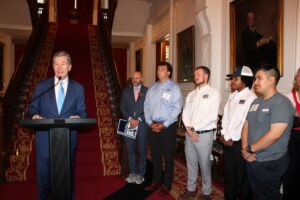
In August 2024, the six state teams met in Raleigh, North Carolina for a culminating convening to bookend their participation in the Policy Academy. During the convening, state teams heard directly from North Carolina Governor Roy Cooper who shared his vision for youth apprenticeship, discussed best practices and common challenges, and detailed policy options to achieve scale and increase accessibility.
This publication highlights key themes from the Policy Academy, recounts Governor-led policy change on youth apprenticeship, and covers what the future of youth apprenticeship policy may hold at the state and federal level.
Policy Academy Themes
Championing Youth Apprenticeship
Governors have the unique ability to direct attention to their initiatives through proclamations, executive orders, budget requests and other means – as discussed in the NGA Center’s State Policy Playbook To Advance Youth Apprenticeship. These actions can be especially impactful for programs that are in the early stages of development.
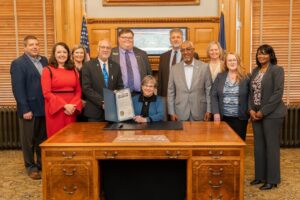
During the first National Youth Apprenticeship Week, Governors of 21 states, commonwealths and territories made their own declarations recognizing May 5 – May 11, 2024, as Youth Apprenticeship Week. Colorado Governor Jared Polis, Kansas Governor Laura Kelly, North Carolina Governor Roy Cooper and Utah Governor Spencer Cox issued proclamations during the Policy Academy that highlight the potential youth apprenticeships have to set young people on a path to a successful career and provide employers with a skilled talent pipeline.
Defining Youth Apprenticeship
The lack of a federal definition for youth apprenticeship has led Governors to establish standards that best suit their states’ economic needs. The Partnership to Advance Youth Apprenticeship is a multi-year collaborative initiative led by New America, and NGA is a national partner of the initiative. Together, New America and partner organizations identified four core elements of a youth apprenticeship:
- Paid on-the-job learning under the supervision of skilled employee mentors;
- Related classroom-based instruction;
- Ongoing assessment against skills and competency standards; and
- Culmination in a portable, industry-recognized credential and postsecondary credit.
Each state in the Policy Academy recognized the need to align partners on a youth apprenticeship definition and worked together to ensure everyone in the state is on the same page when discussing these programs.
| State (Year Defined) | Definition |
|---|---|
| Alabama (2019) | Alabama Code: Section 41-29-331 “Registered Youth Apprenticeship: A program that is designed specifically for individuals aged 16 to 18, inclusive, registered by the Alabama Office of Apprenticeship, and is connected to an adult apprenticeship.” |
| Colorado (2023) | Colorado does not have a codified definition for youth apprenticeship and has rather emphasized the promotion of Quality Pre-Apprenticeship and Registered Apprenticeship for young people. Code of Colorado Regulations: 1108-1 “’Quality pre-apprenticeship program’ is a training model that meets, at a minimum, the federal definition of quality pre-apprenticeship, and any additional criteria established by the SAA for state recognition. Quality pre- apprenticeships are designed to assist individuals who may not currently possess the minimum requirements for selection into a registered apprenticeship program to meet the minimum selection criteria established in a program sponsor’s apprenticeship standards.” |
| Indiana (2023) | Indiana Code: Section 20-51.4-2-9.5 “Modern youth apprenticeship” means a structured, work-based learning program with an aligned, competency based education and training plan in which the student receives* at least two semesters of related academic instruction eligible for secondary academic credit; works on the job at least six hundred fifty hours; is paid for the work experience; earns postsecondary credit as part of the apprenticeship; and the apprenticeship culminates in an industry recognized credential. *Shortened for brevity |
| Kansas (2024) | Adopted by the Kansas Apprenticeship Council “Kansas Youth Registered Apprenticeship: A paid employment and training opportunity that starts as early as 16 years of age.” |
| North Carolina (2018) | ApprenticeshipNC Youth Apprenticeship Guide “Youth Apprenticeship: Youth apprenticeship is an industry driven education and career training program based on recognized industry standards. It is a partnership among business, industry, education, government, parents and youth apprentices. WIOA [Workforce Opportunity and Innovation Act] defines a youth as a person 16-24 years of age. Local definitions of youth include apprentices who are still in high school or who are under the age of 18.” Note: North Carolina considers both Pre-Apprenticeship and Registered Apprenticeship to fall under the definition of Youth Apprenticeship. |
| Utah (2021) | Utah Code: Section 35A-6-102 “Youth Apprenticeship: A program or set of strategies that combines academic and technical classroom instruction with work experience through an apprenticeship program and which provides the foundation for youth in high school to choose among multiple pathways, including enrolling in college, beginning full-time employment, or a combination of college and employment.” |
State Systems Design

During the first Policy Academy peer learning call, state teams discussed various models for youth apprenticeship systems design. The subsequent conversations among the cohort helped inform a policy brief published by NGA in November 2023. The brief describes centralized and decentralized models and offers questions for states to consider on issues of vision and scope, program development and delivery, data tracking and accountability, sustainability, and more.
The cross-system nature of youth apprenticeship makes codifying roles across agency partners especially critical. Recognizing this need, the Utah team worked throughout the project period to pass Utah Senate Bill 122. This new law, signed by Utah Governor Spencer Cox in March 2024, charges a group of key stakeholders with designing a system to expand youth apprenticeship. Importantly, the legislation also includes the directive to identify opportunities to leverage educational programs in conjunction with youth apprenticeships, including career and technical education, concurrent enrollment and stackable credentials. This work will culminate with official recommendations for Utah’s youth apprenticeship system in May 2025.
Opportunity Alignment
Educational institutions often provide related technical instruction for youth apprenticeship programs. Recently, states and the U.S. Department of Labor (U.S. DOL) have begun focusing on the benefits of aligning youth apprenticeship with the career and technical education (CTE) system. CTE courses allow students to explore careers of interest while learning technical and employability skills that align with their academic studies. States in the Policy Academy worked to capitalize on the opportunity to align youth apprenticeship and CTE during the project period.
The Kansas Youth Apprenticeship Collaborative, led by the Office of Registered Apprenticeship, hosted a number of Youth Apprenticeship Champion Trainings for K-12 administrators, CTE administrators and employers. During these trainings, attendees received an overview of apprenticeship programs and discussed how to promote and manage registered apprenticeship programs within their CTE programs.
Throughout the Policy Academy, the Colorado team focused on strengthening connections between apprenticeship and CTE – principally by working to advance legislation that would codify this type of coordination. In May 2024, Colorado Governor Jared Polis signed Senate Bill 24-104, which charges the state apprenticeship agency, in coordination with the career and technical education division of the community college system, with aligning the high school CTE system and the registered apprenticeship system for programs and occupations related to infrastructure, advanced manufacturing, education, health care and other occupations identified in Colorado’s annual Talent Pipeline Report. The legislation stipulates that, by July 2026, the state will expand aligned programs in at least one of the target industries – infrastructure, advanced manufacturing, education, or health care – with the other industries to follow.
North Carolina also emphasized the importance of providing credit for related technical instruction that youth apprentices receive through CTE courses. In the state’s CTE Course Inventory for 2024-2025, there are both “CTE Pre-apprenticeship” and “CTE Apprenticeship” course codes in several programs of study. Having these course codes allows school districts to provide students with credit for their apprenticeship more seamlessly. This can increase the accessibility of apprenticeship and give school systems the ability to count students completing their apprenticeship requirements towards their instructional time requirements.
The Indiana team focused on establishing a set of metrics that will allow policymakers to demonstrate the value of youth apprenticeship programs to key stakeholders. Because Indiana’s definition of youth apprenticeship does not directly align with a single data source at the federal level, the Indiana team is working to determine the best way to measure success for youth apprenticeship that aligns with the needs of employers and students. In collaboration with Advance CTE, a PAYA National Partner, the Indiana team explored possibilities for aligning youth apprenticeship metrics with outcomes already reported under federal programs like Perkins V, the Workforce Innovation and Opportunity Act (WIOA) and the Every Student Succeeds Act.
Addressing Misconceptions Around Workers Compensation
One persistent challenge in scaling youth apprenticeship is the misconception around youth apprenticeship’s impact on workers’ compensation insurance. The U.S. DOL has established that youth apprentices may perform the same tasks required of other workers, with a few exceptions for hazardous occupations, without raising workers’ compensation insurance rates or violating federal law. Employers and insurance providers often have misunderstandings about the impact hiring a youth apprentice has on their insurance.
The Kansas team published a letter from the Kansas Department of Insurance with a complementary memo clarifying that workers’ compensation rates are not tied to the age of employees. This letter equips youth apprenticeship policymakers in Kansas with a new, valuable resource for their conversations with employers or insurance companies that raise this issue as a barrier for not participating in youth apprenticeship. This letter will be an asset as Kansas looks to expand youth apprenticeship across the state and into industries that have not typically hosted youth apprentices.
Convening Employers and Stakeholders
Engaging employers is paramount to the growth of youth apprenticeship. All six states in the cohort emphasized the need to bring more employers into the fold and did so through the distribution of marketing materials, videos highlighting youth apprentices, direct engagement or showing ROI through high-impact metrics.
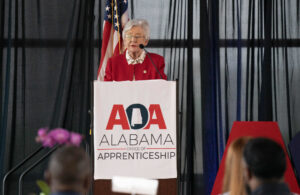
Alabama, which has a robust apprenticeship system, leveraged the state’s focus on work-based learning to connect directly with employers on the value of youth apprenticeship. During the 2024 Alabama Summit on Talent Retention and Work-Based Learning, employers, alongside other workforce and education professionals, discussed the state of play and what is anticipated to come on youth apprenticeship in Alabama.
Youth apprenticeship took center stage during the Summit. Through multiple sessions, participants discussed how states are expanding youth apprenticeship and how employers are finding value in this model to fill their IT needs. By emphasizing youth apprenticeship at the Summit, Alabama was able to reach employers who are engaged in work-based learning but not yet involved with the youth apprenticeship system.
The Road Ahead
As Governors have led on youth apprenticeship policymaking through the Policy Academy, federal policymakers in Congress and in the executive branch are also recognizing the potential youth apprenticeship programs have to solve workforce shortages and provide career connected learning opportunities to young people. At U.S. DOL, this is exemplified by the first federally recognized Youth Apprenticeship Week held in May 2024, along with recently proposed regulatory change that emphasize the importance of providing youth with the ability to engage in apprenticeship. Similar support has recently been expressed by Congress, with the inclusion of the Youth Apprenticeship Readiness Grant Program in the bipartisan WIOA reauthorization discussion draft released by the Senate Health, Education Labor, and Pensions Committee.
While the Policy Academy to Advance Youth Apprenticeship has ended, Alabama, Colorado, Indiana, Kansas, North Carolina and Utah will continue to work among their interagency teams to ensure employers and young people who wish to take advantage of youth apprenticeship will have the opportunity to do so. Likewise, NGA and the Partnership to Advance Youth Apprenticeship will continue to serve as a resource to Governors and their state partners as they advance youth apprenticeship policy.
Acknowledgements
The NGA Center would like to thank New America, the lead organization of PAYA, for their partnership throughout the Policy Academy to Advance Youth Apprenticeship. This playbook was prepared by Jordan Morang, senior policy analyst at the NGA Center, and Jack Porter, program director for workforce development and economic policy at the NGA Center, with guidance and review from Taylor White, national director of PAYA and director of the Center on Education & Labor at New America, and Lancy Downs, senior policy analyst with the Center on Education & Labor at New America.

